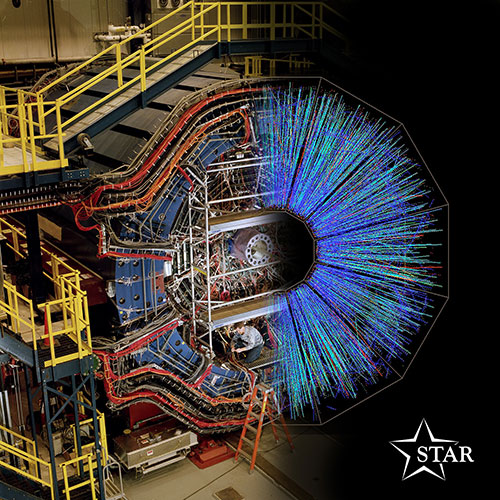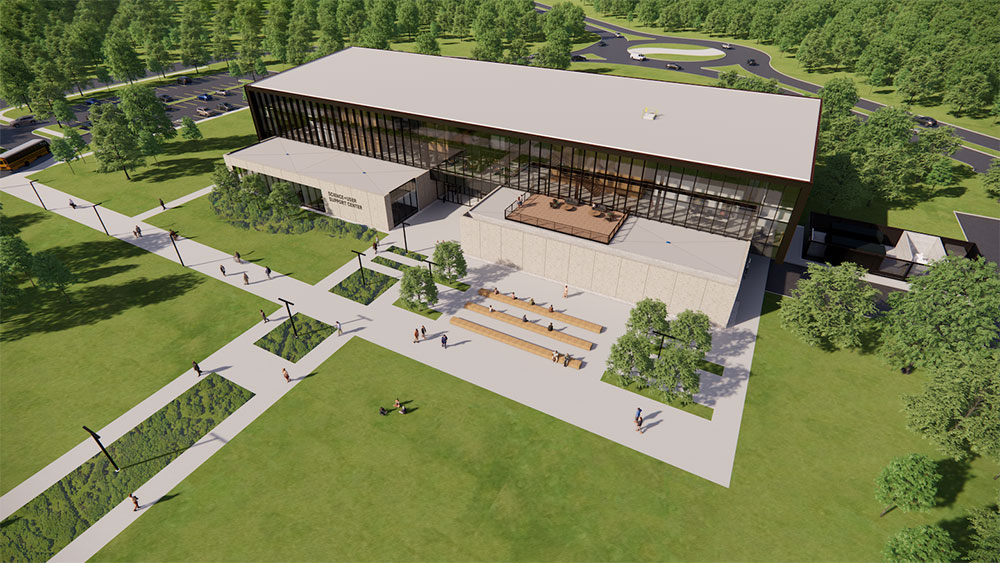From RHIC to EIC: At the QCD Frontiers
Annual users' meeting highlights physics results, future plans, efforts to increase diversity, and more
June 30, 2022
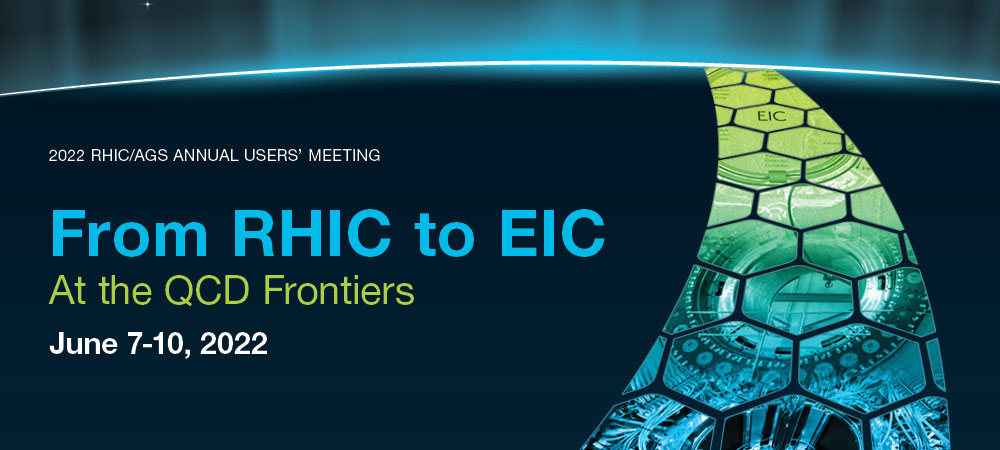
The annual meeting of scientists conducting research at the Relativistic Heavy Ion Collider (RHIC) and its pre-injector accelerator, the Alternating Gradient Synchrotron (AGS), was held virtually June 7–10, 2022. Known as the RHIC & AGS Users’ Meeting, this gathering is a chance for researchers to share their science and hear the latest plans related to RHIC, a U.S. Department of Energy Office of Science user facility for nuclear physics research at DOE’s Brookhaven National Laboratory.
RHIC steers beams of ions—the nuclei of atoms stripped bare of their electrons—into collisions so scientists from all around the world can study fundamental characteristics of the building blocks of matter. The interactions of those building blocks, known as quarks and gluons, are governed by the theory of quantum chromodynamics (QCD). So RHIC is, in essence, a powerful machine for exploring the frontiers of QCD.
Throughout the meeting, attendees heard talks highlighting the latest physics results from RHIC’s STAR and PHENIX experiments—giant 3D digital cameras that take “snapshots” of particles emerging from RHIC’s particle smashups. Physicists also presented recaps of how the collider and experiments performed during RHIC’s latest round of collisions, Run 22. Spoiler alert: The run was “highly eventful, highly challenging, and eventually highly successful,” said Haiyan Gao, Brookhaven’s Associate Laboratory Director for Nuclear and Particle Physics, who oversees the RHIC research program. And there was a lot of excitement at the meeting about future programs—including “hot-off-the-press” photos showing dramatic progress on the sPHENIX detector and the transformation of RHIC into the future Electron-Ion Collider (EIC).
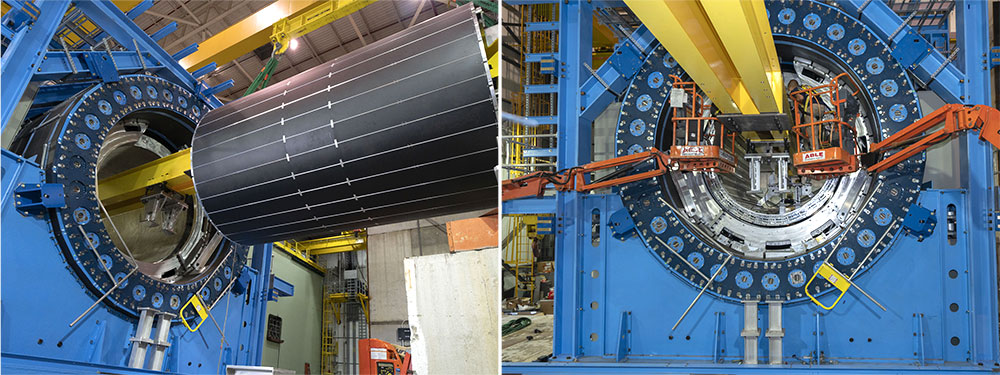 enlarge
enlarge
"Hot-off-the-press" photos of the inner hadronic calorimeter being installed in RHIC's sPHENIX detector on Wednesday, June 8, during the annual RHIC & AGS Users' Meeting.
“We have overcome many challenges and accomplished much over the past two-plus years,” Gao said during the opening talk of the meeting’s first plenary session on Thursday, June 9. She was referring directly to the COVID-19 pandemic, which placed limits on how the Lab was staffed and required new ways of working to keep the science moving. But her comment also applies to the complexity of exploring a state of matter that lasts a mere fraction of a second after being created in RHIC’s particle smashups—as well as keeping up the pace of technological achievements and sustained funding required to make that exploration and future EIC science possible.
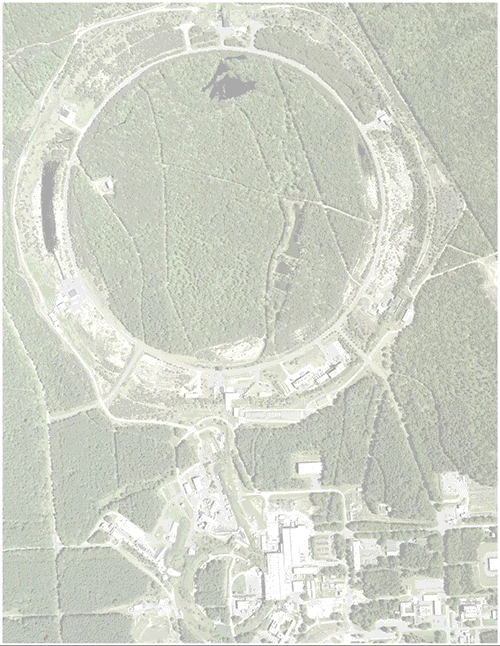 enlarge
enlarge
This schematic shows the chain of accelerators that feed beams of ions into the two rings that make up the 2.4-mile-circumference Relativistic Heavy Ion Collider (RHIC), and how RHIC will be transformed into an Electron-Ion Collider (EIC) by adding components for accelerating and colliding electrons with ions.
Gao noted completion of the “beam energy scan” (BES II) in Run 21. That series of collisions at different energies is allowing scientists to map out the phases of nuclear matter—including the free quarks and gluons that make up a “quark-gluon plasma” created at RHIC’s highest collision energies, and the protons and neutrons of ordinary “hadronic” matter—as well as the types of transitions between these phases at the different energies. “I’m very excited to see the results of the BES II data analysis,” Gao said.
Mapping out these phases was one of two RHIC science goals spelled out in the nuclear physics community’s last Long Range Plan, published in 2015. The second goal was describing the inner workings of the quark-gluon plasma at varying length scales—a central focus of the new sPHENIX detector, an upgrade to PHENIX, which concluded its data taking in 2016. Showing off the latest pictures of inner hadronic calorimeter components installed in the sPHENIX barrel just the day before her talk, Gao said, “I congratulate the entire [sPHENIX] team for making this progress!”
Gao also noted progress on major milestones for the EIC, including the achievement last year of DOE’s Critical Decision 1, approval of alternative selection and cost range, and the international collaborative effort to select a reference design for the EIC project detector.
“The EIC user community worked very hard in producing the ‘yellow report’ with detector requirements, and responding to the call for detector proposals,” she said. “We are very excited by the worldwide interest in EIC physics.”
DOE highlights
As Gao and other speakers noted, progress on all these efforts can only be accomplished with the generous funding allocated by Congress and the DOE Office of Science, Office of Nuclear Physics, which supports a wide variety of science.
“We look at topics throughout the entire evolution of the universe and on physical scales from quarks to galaxies,” said Timothy Hallman, DOE’s Associate Director of the Office of Science for Nuclear Physics (NP). That expansive mission, he noted, “requires ‘microscopes’ and tools of varying resolving ‘power’”—the facilities across the nation whose construction, operations, and research programs account for a large part of the NP budget.
Hallman noted the successful startup of the Facility for Rare Isotope Beams (FRIB) at Michigan State University and a range of other accomplishments across the complex—including at RHIC and the Continuous Electron Beam Accelerator Facility (CEBAF) at Thomas Jefferson National Accelerator Facility, Brookhaven’s partner in building the future EIC. He also noted the ongoing assembly of sPHENIX as “an experiment for the Office of Science, with authority delegated to the Laboratory for construction—and it was very successful.”
Regarding the EIC, he noted that because of the significant cost ($1.7-2.8 billion) and long timeframe for the project, it will be a challenge and take “a significant amount of resolve” to keep it viewed as a top priority in terms of budgets. But he emphasized that the need for new money will be lessened once RHIC completes its scientific program, and that the facility, “is going to help maintain U.S. leadership in accelerator science and the technology of colliders, and already has a huge interest in the user community.”
Getting into the numbers, Hallman showed that funding for fiscal year 22 (FY22) was a large ($93 million) increase over FY21. But he noted that FY21 was an anomalous year when funding for nuclear physics discovery science went down. The increase, he said, included $20 million of new funding allocated for EIC construction in FY22 (on top of $28.4 million in reprioritized funds)—still “not sufficient.” But he noted that, “it could have been a disaster if Congress had not given us that sizable increase.”
The picture for FY23, with the President’s budget request including only an $11 million increase for NP over the FY22 enacted budget, means, “we still have work to do,” Hallman said.
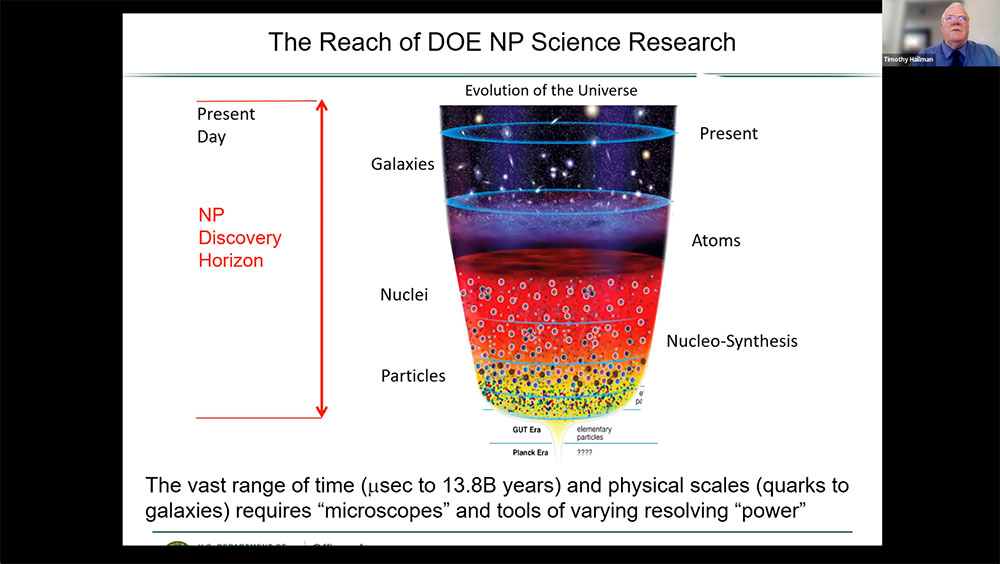 enlarge
enlarge
Timothy Hallman, the Department of Energy's Associate Director of the Office of Science for Nuclear Physics (NP), presented an update that included projects exploring the entire span of the evolution of the universe and from the scale of quarks to the cosmos.
Several points Hallman made at the start of his talk—emphasizing the importance of the nuclear physics workforce to the nation—could help to make case for NP funding.
“One of our most important products, in addition to knowledge, facilities, and new technologies is a highly trained, diverse workforce capable of supporting DOE and other missions,” he said. “U.S. science, commerce, medicine, and defense all benefit, in part, from a stable level of sustained competence, capability, capacity, and leadership in nuclear physics. DOE NP is the U.S. steward responsible for reliably delivering that benefit.”
One key to success in both science and funding, Hallman advised, is for the field to stay united in establishing the next nuclear physics Long Range Plan.
“We have a long tradition of partnership,” he said, noting how a united front has achieved much success in the field. “We need to all come up with a plan we can collectively get behind. If we imagine that if we just get rid of something someone else wants [to achieve our individual goals], that is a failed strategy,” he said.
Later in the day, Kenneth Hicks, the DOE NP program manager for heavy ion physics, elaborated on how NP strives to balance different program initiatives with future strategies, and emphasized the need for the community to be involved.
“I really depend on the views from experts to do my job properly,” he said. “So, if you are asked to review a project, please say yes. If you get an email survey about priorities and goals, please reply. Schedule a Zoom meeting with me if you’d like to discuss program priorities.”
“A lot of very exciting things are going on in our field,” he said, reinforcing Hallman’s suggestion of developing a consensus. “But that’s not for me to come up with; [that’s a job] for the community.”
James Sowinski, the retiring DOE program manager for NP facilities, shared a some departing words, recounting his early days as a STAR collaborator and the role he played in the RHIC spin program before joining DOE, as well as his former roles on the RHIC & AGS Users Executive Committee.
“The future is bright,” he said. “I intend to follow NP as a hobby, including the success of sPHENIX, completion of RHIC physics program, and the EIC.”
Diverse, technically skilled workforce
Hallman, Gao, and other plenary speakers also described the importance of increasing the diversity of the NP workforce—to bring people from more diverse backgrounds into the field, make them feel welcome, and help them to succeed.
“I’m very encouraged by the session we had yesterday,” said, Gao pointing out how efforts discussed during a half-day workshop devoted to this topic the day before the plenary session “highlight the collaboration between the Laboratory and [RHIC & AGS] users to work together on the ‘pipeline.’”
Hallman noted the success of a new NP traineeship program that has included students from 18 Minority Serving Institutions (MSIs). Among the first 110 students participating in this program, 40 percent are Hispanic and 40 percent Black. With the aim of retaining students once they are introduced to the field of nuclear physics, Hallman said we’ll need to find ways to sustain investment at Historically Black Colleges and Universities (HBCUs) and MSIs, possibly by linking programs to other fields important to the Office of Science. Many fields could benefit from NP-related skills, including imaging and cryogenics, and students trained with these skills could go on to apply their expertise in many types of jobs across the economy.
Bringing the “missing millions” of underrepresented minorities into the science, technology, engineering, and mathematics (STEM) workforce is one of three main points guiding the vision of the director of the National Science Foundation (NSF), said Allena Opper, Program Director for Nuclear Physics – Experiment in Mathematical and Physical Sciences (MPS) at NSF.
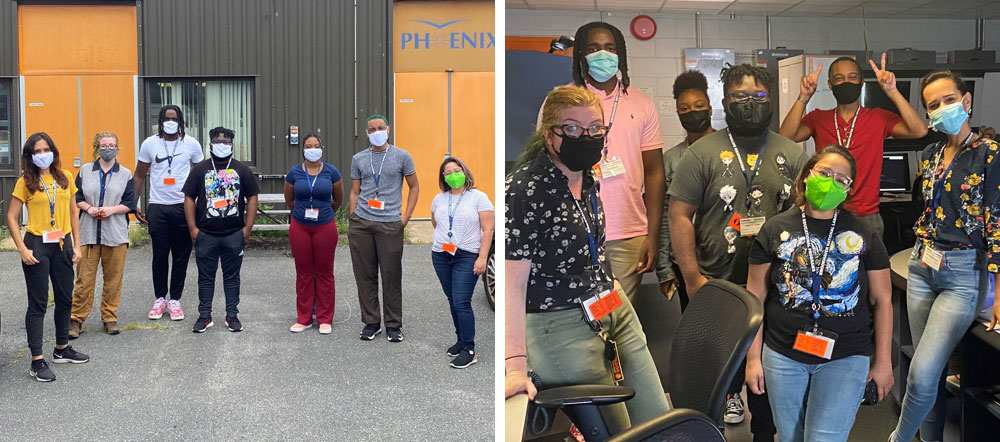
Students from the first cohort of the BNL-MSI Fellowship Program for Research Excellence and Preparation in Nuclear Physics, part of the DOE NP Traineeship pilot program, visited PHENIX and STAR last summer.
The President’s requested FY23 budget for NSF includes what she calls a “huge bump” overall—a 24 percent increase over what was allocated in FY21—with 9.6 percent to MPS, including 4 percent dedicated to physics. In describing how that funding would be allocated, she included several programs offering support to faculty, graduate students, and postdoctoral fellows that aim to develop role models and increase participation among underrepresented groups.
The other two major areas NSF will focus on with its funding “bump” are strengthening existing research capabilities and accelerating partnerships, Opper said. She noted there had been a dip in proposals in FY21 and FY22—likely due to COVID—and encouraged RHIC & AGS users interested in learning more to reach out to her or her colleagues in the experiment and theory programs.
At Friday’s plenary session, Noel Blackburn, Brookhaven Lab’s Chief Diversity Officer, invited meeting attendees to consider, “What type of collaboration and environment do we want to create? Is it welcoming and respectful and allowing you to be your authentic self?”
Many diversity, equity, and inclusion efforts focus only on “compliance,”— simply having programs in place, he said. “We want to take it to another level, to leverage diversity, equity, and inclusion to meet our mission.”
Internally, he said, “We want to work with every member of the Lab’s community such that we will welcome, respect, and value all the diverse perspectives every member provides.”
But a big part of the future is to focus efforts on reaching new external partners. “We’re looking to enhance and diversify the STEM pipeline for Brookhaven, DOE, and the nation while creating access for those unfamiliar with our mission. Our efforts will increase awareness of Brookhaven among diverse communities of potential supporters, users, and staff,” Blackburn said.
Read more about the DEI-focused workshop at the RHIC & AGS Users Meeting.
Troubleshooting through Run 22
One highlight of the annual meeting is always the recap of the latest RHIC run. One main goal of Run 22 was to use RHIC’s ability to accelerate protons with their “spins” aligned in a particular direction to track how quarks and gluons within these particles move or align their spins with respect to that frame of reference, making use of newly installed upgrades of the STAR detector.
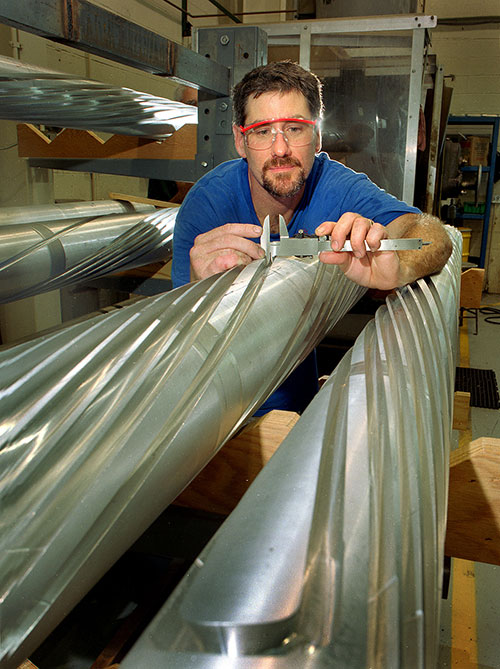 enlarge
enlarge
The corkscrew pattern in RHIC's Siberian snake magnets is designed to flip the spin alignment of accelerated protons 180 degrees each time they pass through. In Run 22, Collider-Accelerator Department staff had to troubleshoot their way through a problem with one of the snakes.
But as Gao hinted and Vincent Schoefer, the Collider-Accelerator Department physicist who served as run coordinator described in detail, the run got off to a bumpy start. Two December power failures plagued one of RHIC’s “Siberian snake” accelerator magnets.
The snakes’ job is to flip the spins of the protons 180 degrees—up to down, or down to up—each time they pass through. The flipping acts as a reset switch to keep the particles’ spins aligned, or polarized. Without the snakes, protons quickly lose polarization, similar to the way spinning tops start to wobble before coming to a stop.
With help from the C-AD’s Power Supply Group and support from the Lab’s Superconducting Magnet Division in the middle of December, the physicists devised a way to wire the functioning parts of the magnet together to achieve a “partial snake”—a type of magnet used in the AGS. The team had to make a series of other fixes to deal with particles entering the collider at a tilt and “very tight steering tolerances” as they raced around the 2.4-mile circumference accelerator at nearly the speed of light.
“We implemented all the tricks we had learned and [the polarization] jumped up to 50 percent,” Schoefer said. That was December 29, and “the first point where the run looked almost plausible,” he said. Adjusting the beam to a slightly lower energy got the protons aligned as near to vertical as possible. “We were happy to find a solution that made [polarization in RHIC’s ‘blue’ ring] look quite nice,” Schoefer said.
Then, in January, a motor generator in the AGS failed.
“The good news is we have a backup, but it has a slower ramp rate, which can lead to polarization loss. It needed a lot of babysitting,” Schoefer said, until the original generator could come back online and bring the polarization back up.
STAR-studded data delivery
Throughout the run the accelerator physicists were in constant communication with physicists at STAR. Spin rotators at STAR were used to reliably measure the direction of the beam polarization so the physicists could account for the slight tilt in their measurements and make the most of the beams the accelerator could deliver. Those measurements at STAR also helped the accelerator physicists determine how to refine the beams.
“This was a great example of collaboration between the experiment and the accelerator teams,” Schoefer said.
And thanks to DOE, the team was able to extend the run by two weeks.
“That two-week extension helped us make it to our goals; we are extremely grateful,” Schoefer said. The accelerator physicists were even able to make some progress on instrumentation commissioning for a future accelerator goal.
“You all should be thanked for the yeoman effort you put it,” said Carl Gagliardi, a STAR collaborator from Texas A&M University. “It was truly remarkable to watch and be part of.”
STAR collaborator Zilong Chang of Indiana University, who presented STAR’s take on Run 22, agreed. Giving credit to the STAR graduate students, Brookhaven Lab engineers, and everyone else who worked to get the STAR forward upgrades installed on budget and on time, he was extremely grateful that the December snake failure and other issues didn’t scuttle the run.
“C-AD came up with this magic to run with a partial snake and it turned out to work really well,” he said. “Once we found the lower energy to get better stability in the polarization angle alignment to the vertical axis…it allowed us to align the forward detectors and make precise cross-section measurements.”
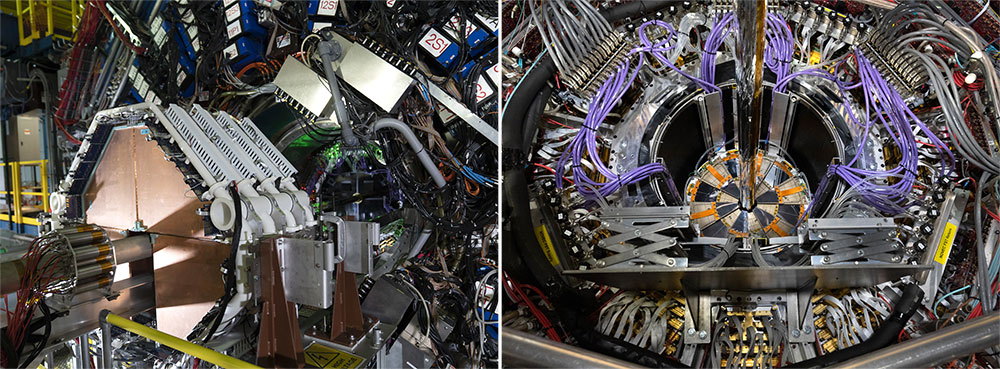 enlarge
enlarge
Run 22 put all the new STAR detector systems through their paces with no significant issues.
The overall luminosity ended up being better than the average for Run 17, the last time polarized protons were run at RHIC and higher than STAR had requested. The collaboration was only a couple of percent short of achieving the data level they needed for one physics goal, with six percent more data than they needed for another.
Run 22 also put all the new STAR detector systems through their paces with no significant issues. Looking forward to next year’s gold-gold collision run, Chang said, “Our forward upgrade detectors are ready.”
Physics highlights from PHENIX
Cesar da Silva of Los Alamos National Laboratory presented the most recent highlights from RHIC’s PHENIX collaboration, which continues to analyze data taken before it was shut down to begin the transformation to sPHENIX. He mentioned several new results in spin physics that are aimed at accessing the gluons within nuclear matter and may be used as a step toward mapping out the 3D internal structure of the proton.
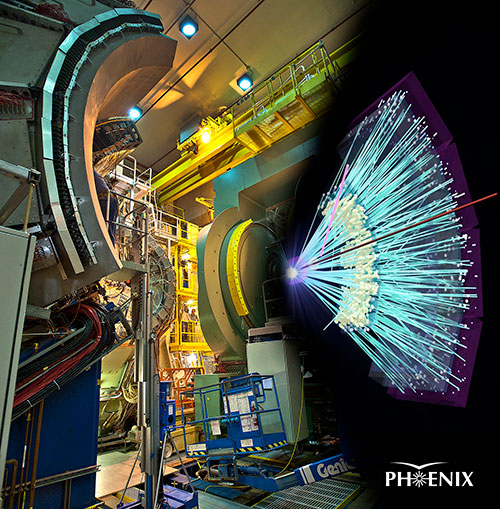 enlarge
enlarge
Composite photo of RHIC's former PHENIX detector and particle tracks recorded by the detector.
He also described measurements of direct photons emerging from heavy ion collisions (ex., gold-gold) that can access all stages of the collision as it evolves from initial cold nuclear matter through the quark-gluon plasma to a hadronic gas. These measurements give access to the temperature of the medium created in these collisions. Comparisons with models show the measurements are consistent with thermal and pre-equilibrium stages in central events.
Da Silva also presented new measurements of high-energy direct photons and neutral pions based on analysis of data collected in deuteron-gold collisions in 2016. The results indicate that the neutral pion yield is suppressed relative to direct photons in the most central deuteron-gold collisions. This could be the first hint of energy loss of quarks and gluons in small collision systems.
Results on jets emerging from collisions when quarks or gluons split to form a spray of particles reveal differences in how particles in different parts of the jet—and particles with different masses—lose energy as they travel through the quark-gluon plasma.
High statistics measurements of electrons from the decay of heavy charm and bottom quarks were also presented. These results showed that the energy loss of the more massive botton quark is smaller than that of the charm quark, which is about one-quarter the mass. This heavy flavor energy loss measurement is a long-awaited result from PHENIX, da Silva said.
“We still have a vibrant PHENIX collaboration,” he said. As the collaboration works to preserve data for future analyses, he noted that PHENIX physics has made unique contributions in several studies of quantum chromodynamics (QCD) and quark-gluon plasma (QGP).
“Students who came [to the collaboration] after PHENIX ended operation are a vital part of the collaboration and [will be] responsible for more discoveries,” he said, noting a couple of upcoming publications.
Physics highlights from STAR
Takafumi Niida of the University of Tsukuba in Japan presented the highlights from STAR. In addition to noting again the completion of data taking for the Beam Energy Scan (BES) II and the commissioning of forward detectors in Run 22, he presented new explorations of “cold QCD”—meaning studies of collisions that don’t create hot quark-gluon plasma but can be used to explore other characteristics of nuclear matter in its initial state—as well as hot QCD.
For example:
- High energy collisions of spin polarized protons at STAR are exploring how gluons’ spins contribute to overall proton spin with higher precision than ever before using data from runs in 2013 and 2015.
- Looking at how back-to-back pairs of particles emerge in various collision types shows signs of a saturated state of gluons.
- Interactions of photons (particles of light) surrounding colliding ions are helping STAR physicists measure the range of the strong force interaction—the force that binds quarks.
- Results from isobar collisions show the expected difference in magnetic field strength, but not the predicted signatures of the chiral magnetic effect. Still, data collected in these collisions offer a wealth of other areas of study.
“We have many interesting results from cold QCD and hot QCD physics at STAR, and new results from high statistics isobar and BES II data,” Niida said. “More results from the full BES II data will be coming soon, and many interesting physics with the forward upgrades will come in 2023 and beyond.”
sPHENIX, EIC, and the future
Friday’s plenary session also included updates on the search for signatures of the chiral magnetic effect (CME) by STAR, progress on the sPHENIX detector, and an EIC project overview followed by detailed talks on the EIC accelerator, physics goals, and detector development.
“This will be the final presentation of sPHENIX at the RHIC & AGS Users’ Meeting before we become an operating experiment,” said Cameron Dean of the Massachusetts Institute of Technology.
“We are starting to install all of our subsystems into the detector,” he said, sharing a video showing the installation of the inner hadronic calorimeter that had taken place just two days earlier. The calorimetry will add capabilities for studies of particle jets in ways that have never been done at RHIC before, he said. His talk included details of individual detector components and how they’ll contribute to sPHENIX’s broad physics program studying jets, heavy flavor, quarkonia, and cold QCD.
The insertion of the inner hadronic calorimeter at sPHENIX was a big success.
He even showed images of the first particles passing through the sPHENIX detector—showers of cosmic rays from outer space!
“sPHENIX will have all detectors in place and ready to go for first data taking in February of 2023!”
Jim Yeck, project director for the EIC, started his talk by referring to the progress on sPHENIX: “This is our goal at EIC—to show hardware being installed! But we have a way to go yet.”
He described the process to date for establishing the scientific goals and machine parameters for the EIC. “It’s a significant project in terms of the scale of investment and technologies needed to make it successful,” he said, noting that DOE’s “critical decision” system of gateway approvals is “a big driver in how we make our plans and propose to move forward with technical progress.”
He noted the uncertainty in funding over the past year, but also “fantastic progress in moving forward on the project detector” reference design.
The challenges and successes “encourage us to lean forward—to use every penny to make progress,” he said.
“We are trying to get the new funding needed now so we can take advantage of reprioritized funds and the people who become available” when RHIC completes its operational period, he said. “Lower amounts will lead to a longer project timeline and ultimately higher cost of the machine,” he said. He noted that the project team is working closely with DOE to make these points to Congress.
But he concluded by focusing on the progress and the collaborations forming around the machine and the project detector.
“A lot of young people are joining the effort, which is really encouraging,” he said. “This is workforce development at its finest.”
Meeting attendees also heard references to efforts to address current and future users’ concerns and comforts.
“In the last couple years, we’ve been real busy,” said Associate Laboratory Director for Facilities & Operations Tom Daniels. “Even though the pandemic hit and not as many folks have been on site, it hasn’t stopped us from doing the work that needs to be done to make the Laborotary a better place.”
A search is underway for a local food vendor to provide cafeteria services, Daniels said. The Lab will increase immediate food services on site with food trucks and pop-up vendors as needed, said Gao.
Looking forward, single-use bathrooms at Brookhaven will soon be labeled as gender-neutral facilities and a design for a non-gender-specific, handicap-accessible dorm wing has been completed, Daniels said.
Construction is in progress on the Science and User Support Center, which will serve as a one-stop processing and welcome center for guests, researchers, and facility users near Brookhaven Lab’s main entrance. The 75,000 gross-square-foot building is anticipated to be completed in 2024 and will house new meeting and conferencing spaces in addition to office areas.
Awards and election results
The RHIC & AGS Users’ Meeting always includes the announcement of a series of awards and the results of elections for new officers on the RHIC & AGS Users’ Executive Committee (UEC). And the winners are:
Thesis awards
- Niveditha Ram, Stony Brook University: “Nuclear modification of hard scattering processes in small systems at PHENIX”
- Krista Smith, Florida State University, “Measurement of J/Ψ and Ψ (2S) at forward and backward rapidity in p+p, p+Al, p+Au, and 3He+Au collisions”
Merit awards
- Yingying Shi, Shandong University, “For her significant contributions to the STAR forward upgrade program, including prototyping, mass production, and quality assurance of the Forward sTCG Tracker”
- Raghav Kunnawalkam Elayavalli, Yale University “For his numerous contributions to measuring and interpreting jet and jet-like correlations at RHIC, and for his services as working group convener in STAR”
- Xu Sun, University of Illinois at Chicago, “For his key contributions to STAR Forward Silicon Tracker construction, commissioning, and operations in Run22, and breakthrough discovery of global spin alignment of phi mesons in heavy-ion collisions at RHIC”
- Zaochen Ye, Rice University, “For his dedication to STAR Time-of-Flight detector operation and calibration, and breakthrough analysis of dielectron continuous spectra related to the QCP radiation”
Election results
- Chair-elect: Marzia Rosati, Iowa State University
- General members:
- Megan Connors, Georgia State University
- Raghav Kunnawalkam Elayavalli, Yale University
- Hanna Paulina Zbroszczyk, Warsaw University of Technology
- Student/Postdoc members:
- Roli Esha, Stony Brook University
- Maria Stefanik, Warsaw University of Technology
- Agnieszka Sorensen, UCLA/Lawrence Berkeley National Laboratory
Poster award
- Derek Murphy Anderson, Texas A&M: “Reconstruction of neutral-triggered recoil jets in √SNN= 200 GeV p+p collision at STAR experiment”
The meeting concluded with a big thank you to the staff in Brookhaven’s Guest, User & Visitor Center, and particularly Kelly Guiffreda, who set up registration and ensured that everything ran smoothly in the meeting’s virtual environment.
Research at RHIC and the facility’s operations, the sPHENIX upgrade, and the EIC project are all funded by the DOE Office of Science.
Brookhaven National Laboratory is supported by the Office of Science of the U.S. Department of Energy. The Office of Science is the single largest supporter of basic research in the physical sciences in the United States and is working to address some of the most pressing challenges of our time. For more information, visit science.energy.gov.
Follow @BrookhavenLab on Twitter or find us on Facebook.
2022-20669 | INT/EXT | Newsroom




